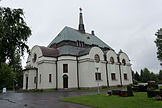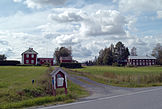South Ostrobothnia
South Ostrobothnia
| |
|---|---|
| Region of South Ostrobothnia Etelä-Pohjanmaan maakunta Landskapet Södra Österbotten | |
 Flag  Coat of arms | |
 South Ostrobothnia on a map of Finland | |
| Coordinates: 62°45′N 22°30′E / 62.750°N 22.500°ECoordinates: 62°45′N 22°30′E / 62.750°N 22.500°E | |
| Country | Finland |
| Historical province | Ostrobothnia, Satakunta |
| Capital | Seinäjoki |
| Area | |
| • Total | 13,999.63 km2 (5,405.29 sq mi) |
| Population (2019) | |
| • Total | 188,685 |
| • Density | 13/km2 (35/sq mi) |
| ISO 3166 code | FI-03 |
| NUTS | 194 |
| Regional bird | Eurasian curlew (Numenius arquata) |
| Regional flower | Fireweed (Epilobium angustifolium) |
| Website | etelapohjanmaa.fi |
South Ostrobothnia[1] (Finnish: Etelä-Pohjanmaa; Swedish: Södra Österbotten) is one of the 19 regions of Finland. It borders the regions of Ostrobothnia, Central Ostrobothnia, Central Finland, Pirkanmaa, and Satakunta. Among the Finnish regions, South Ostrobothnia is the ninth largest in terms of population.[2] Seinäjoki is the regional centre and by far the largest city in the area.
As a cultural area, South Ostrobothnia is larger than its current regional borders and includes the region of Ostrobothnia as well.[3]
Historical provinces[]
Municipalities[]
The region of South Ostrobothnia is made up of 17 municipalities, of which eight have city status (marked in bold).
|
Järviseutu sub-region:
Kuusiokunnat sub-region: |
Suupohja sub-region:
|
Culture[]
Some people have made this region better known to the world. For example, The Dudesons and the traditional Finnish sweater are something people would remember when asked about South Ostrobothnia.
One of the biggest rock festivals in Finland, Provinssirock and world's oldest tango festival Tangomarkkinat are both held in Seinäjoki.[3]
Regional identity is generally stronger in South Ostrobothnia than in most regions of Finland.[4]
Politics[]
Results of the 2019 Finnish parliamentary election in South Ostrobothnia:
- Centre Party 31.66%
- Finns Party 22.02%
- National Coalition Party 17.64%
- Social Democratic Party 10.79%
- Christian Democrats 6.39%
- Green League 4.22%
- Left Alliance 2.81%
- Blue Reform 1.82%
- Swedish People's Party 0.41%
- Seven Star Movement 0.37%
- Other parties 1.87%
Gallery[]

Seinäjoki Town Hall and Lakeuden Risti Church tower by Alvar Aalto

Yli-Laurosela, a museum for Ostrobothnian peasant culture in Ilmajoki

Typical Ostrobothnian plains in Töysä
Lapua Cathedral, the only wooden cathedral in Finland
Lake Lappajärvi, Lappajärvi

Kuortane Church
Marshland in Kauhaneva-Pohjakangas National Park, Kauhajoki
A street view in Seinäjoki
A poor man statue at Lappajärvi Church

Alavus Church
Typical barns of two different ages in Lappajärvi

Lehtimäki Church
The Ostrobothian horizont in Jalasjärvi
Bears in Ähtäri Zoo

A village landscape in Kuortane

The limestome quarry in Vimpeli
Kauhajoki town centre

A building of Veljekset Keskinen, a shopping mall in rural area in Tuuri, Töysä

Pesäpallo (Finnish baseball) in Vimpeli

Koskenkorva distillery in Koskenkorva, Ilmajoki

Interior of Torikeskus shopping center in Seinäjoki
See also[]
References[]
- ^ https://www.stat.fi/meta/luokitukset/maakunta/001-2018/index_en.html
- ^ [1] (in Finnish)
- ^ Jump up to: a b "Etelä-Pohjanmaata ja pohjalaisia | Elävä arkisto | yle.fi". yle.fi (in Finnish). Retrieved 2021-04-11.
- ^ "Studies on Finnish attitudes and identities | The Finnish Cultural Foundation". skr.fi. Retrieved 2021-04-11.
External links[]
| Wikimedia Commons has media related to South Ostrobothnia. |
- Southern Ostrobothnia
- Western Finland Province
- Regions of Finland






















